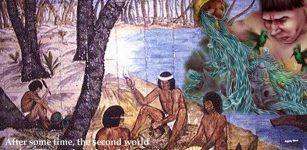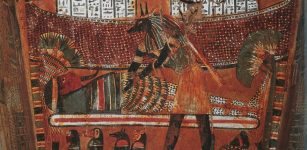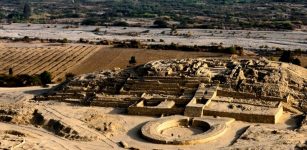Kalpa Tree ‘Kalpavriksha’: The Sacred Wishing Tree Has Been Object Of Adornment And Worship Since Ancient Times
A. Sutherland - AncientPages.com - Worshiping trees is one of the oldest traditions in India. One such sacred tree is the Kalpa Tree, also known as the Kalpavriksha, which is believed to be a wishing tree. This tree produced the fruit that nourished the first men.
Kalpavriksha is a unique tree, a divine tree, a celestial tree, or a spiritual tree.
According to ancient beliefs, the Kalpa Tree should be revered because it has a solid connection to the divine and means much more than only fulfilling people's wishes.
It is a sacred object in Buddhism and Jain cosmology and is often mentioned in Sanskrit literature from the earliest sources and in Hindu myths. In Hindu religious beliefs, Kalpavriksha is considered the tree of life – the "World Tree" mentioned in the Vedic scriptures.
The king of the gods, Indra, the most important god in the Vedic religion, returned with Kalpavriksha to his abode and planted it at Mt. Meru peak in the middle of Indra's five paradise gardens.
But why did Indra take the sacred Kalpavriksha tree to his paradise?
Kalpataru, the divine tree of life being guarded by mythical creatures Kinnara and Kinnari, flying Apsara (a female spirit of the clouds and waters in Hindu and Buddhist mythology) and Devata - 8th-century Pawon temple, Java, Indonesia. Credit: Gunawan Kartapranata - CC BY-SA 3.0
A myth explains that Kalpavriksha was once on earth, but people started misusing it by wishing evil and wrong things.
In Indra's "Devaloka" (or "deva loka") - a plane of existence for both gods and devas - there are as many as five Kalpavrikshas, which are called Mandana, Parijata, Santana, Kalpavriksha, and Harichandana.
In Jainism, an ancient Indian religion, there are as many as ten sacred Kalpavrikshas.
Kalpavrikshaand Peacocks, Shiva Temple, Prambanan, Central Java. Credit: Photo Dharma - CC BY 2.0
These trees grant wishes regarding garments, utensils, nourishment, place to reside, ornaments, pleasant music, wonderful aromatic flowers, and shining lamps. All these trees fulfill various wishes.
Kalpavriksha - famous in iconography and widely described in ancient literature - is also identified with several other sacred trees because the different trees hold religious importance in India and other countries of the Far East. With time, they acquired social and religious sanctity.
Written by – A. Sutherland AncientPages.com Staff Writer
Updated on Dec 7, 2023.
Copyright © AncientPages.com All rights reserved. This material may not be published, broadcast, rewritten or redistributed in whole or part without the express written permission of AncientPages.com
Expand for referencesReferences:
D. L. Haberman, People Trees: Worship of Trees in Northern India
More From Ancient Pages
-
 On This Day In History: The Warsaw Uprising Began – On August 1, 1944
News | Aug 1, 2016
On This Day In History: The Warsaw Uprising Began – On August 1, 1944
News | Aug 1, 2016 -
 Prehistoric Bone Tool ‘Factory’ Shows Human Ancestors Had Advanced Reasoning Skills One Million Years Earlier Than Believed
Evolution | Mar 11, 2025
Prehistoric Bone Tool ‘Factory’ Shows Human Ancestors Had Advanced Reasoning Skills One Million Years Earlier Than Believed
Evolution | Mar 11, 2025 -
 Christian Church And Large House Unearthed In Ancient Laodicea, A Major Hub Of Christianity
Archaeology | Oct 31, 2020
Christian Church And Large House Unearthed In Ancient Laodicea, A Major Hub Of Christianity
Archaeology | Oct 31, 2020 -
 Revealing 1,200 Years Of Arctic Canadian Cultures And Settlements In Canada
Archaeology | Jul 11, 2024
Revealing 1,200 Years Of Arctic Canadian Cultures And Settlements In Canada
Archaeology | Jul 11, 2024 -
 Creator God Kururumany Who Introduced Death Into The World And Deprived Humans Of Immortality
Featured Stories | Dec 19, 2016
Creator God Kururumany Who Introduced Death Into The World And Deprived Humans Of Immortality
Featured Stories | Dec 19, 2016 -
 Legend: Strange Encounter With The Fairies In The Land Of The Light
Myths & Legends | Oct 14, 2024
Legend: Strange Encounter With The Fairies In The Land Of The Light
Myths & Legends | Oct 14, 2024 -
 On This Day In History: Noah Webster, Jr. “Father Of American Scholarship And Education” Was Born – On Oct 16, 1758
News | Oct 16, 2016
On This Day In History: Noah Webster, Jr. “Father Of American Scholarship And Education” Was Born – On Oct 16, 1758
News | Oct 16, 2016 -
 Earliest Record Of An Aurora Discovered In The Bamboo Annals
Archaeology | Apr 15, 2022
Earliest Record Of An Aurora Discovered In The Bamboo Annals
Archaeology | Apr 15, 2022 -
 Sinister Manchac Swamp And The Chilling Curse Of Julia Brown
Featured Stories | Aug 25, 2021
Sinister Manchac Swamp And The Chilling Curse Of Julia Brown
Featured Stories | Aug 25, 2021 -
 Trident: Powerful Religious Symbol Found In Many Ancient Cultures
Ancient Symbols | Dec 4, 2019
Trident: Powerful Religious Symbol Found In Many Ancient Cultures
Ancient Symbols | Dec 4, 2019 -
 Oldest Human Genome From The Iberian Peninsula Helps Reconstructing Human History
Archaeology | Mar 1, 2023
Oldest Human Genome From The Iberian Peninsula Helps Reconstructing Human History
Archaeology | Mar 1, 2023 -
 Artificial Intelligence And Clay Tablets: Not Yet A Perfect Match
Scripts, Paintings & Inscriptions | Oct 12, 2023
Artificial Intelligence And Clay Tablets: Not Yet A Perfect Match
Scripts, Paintings & Inscriptions | Oct 12, 2023 -
 Immortal God Anubis: Lord Of The Sacred Land, Jackal God Of Mummification
Egyptian Mythology | Sep 19, 2016
Immortal God Anubis: Lord Of The Sacred Land, Jackal God Of Mummification
Egyptian Mythology | Sep 19, 2016 -
 Lazarus – An Obscure Biblical Figure
Biblical Mysteries | May 3, 2019
Lazarus – An Obscure Biblical Figure
Biblical Mysteries | May 3, 2019 -
 Mystery Of 3,000-Year-Old Conical Hats – Was It A Highly Advanced Device?
Artifacts | Jun 20, 2020
Mystery Of 3,000-Year-Old Conical Hats – Was It A Highly Advanced Device?
Artifacts | Jun 20, 2020 -
 Ancient Board Game Mancala Can Unlock Cutting-Edge Physics Discoveries
Artifacts | Sep 30, 2023
Ancient Board Game Mancala Can Unlock Cutting-Edge Physics Discoveries
Artifacts | Sep 30, 2023 -
 America’s Oldest City Caral Illegally Invaded And Archaeologist Threatened With Death
Archaeology | Jan 21, 2021
America’s Oldest City Caral Illegally Invaded And Archaeologist Threatened With Death
Archaeology | Jan 21, 2021 -
 Remains of Maurya-Era Wall Discovered In Tilaurakot, Kapilvastu, Nepal
Archaeology | Jun 16, 2022
Remains of Maurya-Era Wall Discovered In Tilaurakot, Kapilvastu, Nepal
Archaeology | Jun 16, 2022 -
 13th Century Black Book Of Carmarthen: Erased Poetry And Ghostly Faces Revealed By UV Light
Artifacts | Apr 4, 2015
13th Century Black Book Of Carmarthen: Erased Poetry And Ghostly Faces Revealed By UV Light
Artifacts | Apr 4, 2015 -
 Spectacular Vespasianus Titus Tunnel – An Ancient Roman Engineering Marvel
Ancient Technology | Aug 30, 2018
Spectacular Vespasianus Titus Tunnel – An Ancient Roman Engineering Marvel
Ancient Technology | Aug 30, 2018



